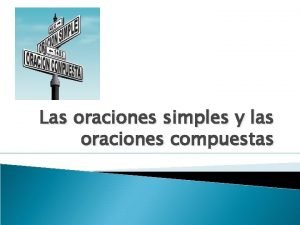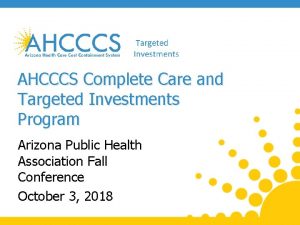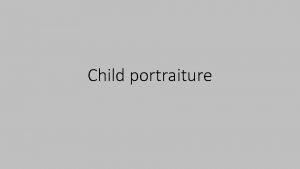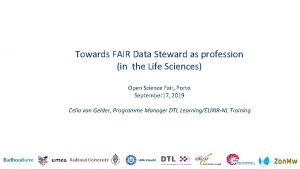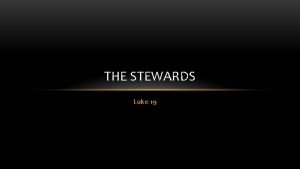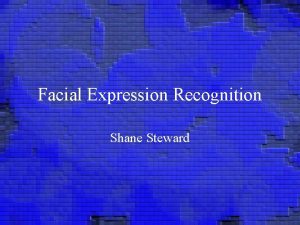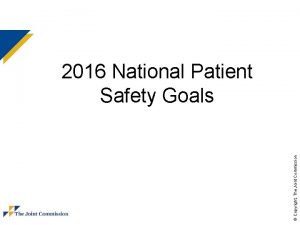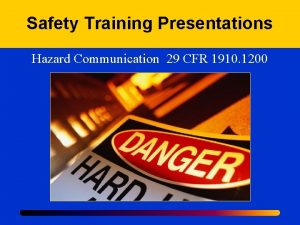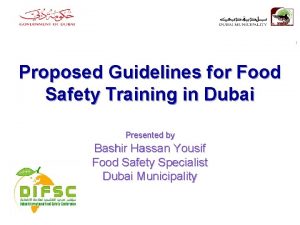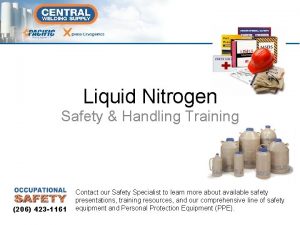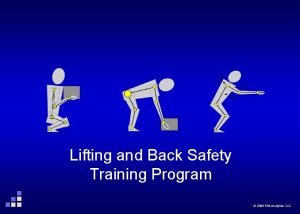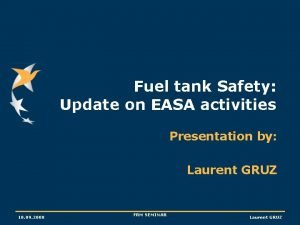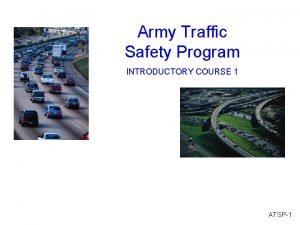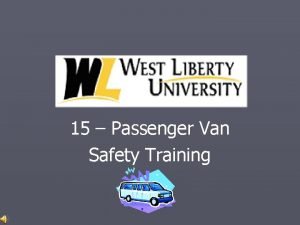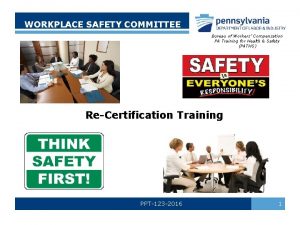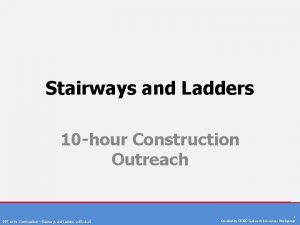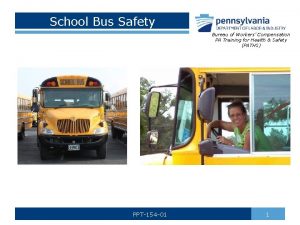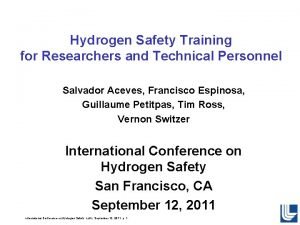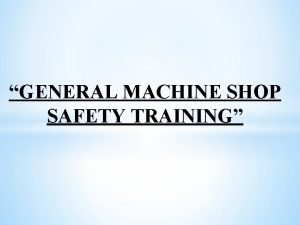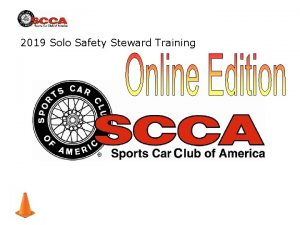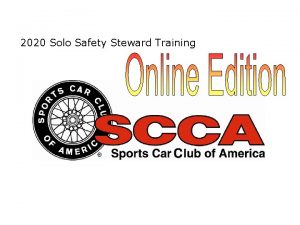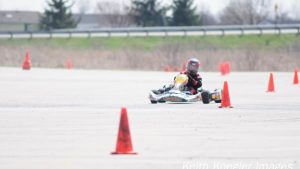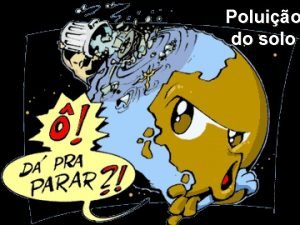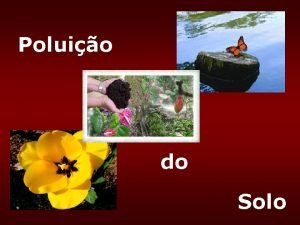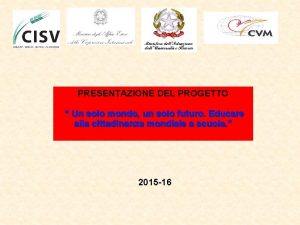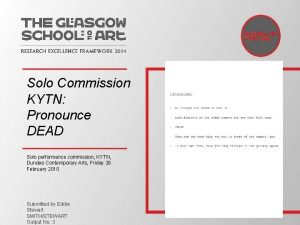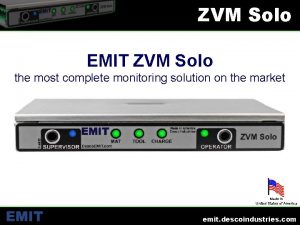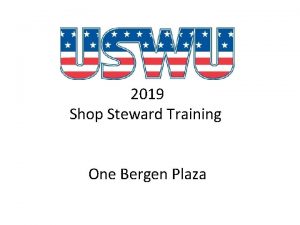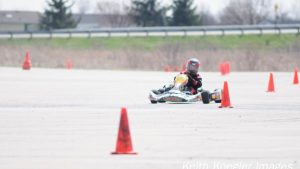2016 Solo Safety Steward Training What Is a





























- Slides: 29

2016 Solo Safety Steward Training

What Is a Solo Safety Steward? A person accepting responsibility from the SCCA to: Know and execute the regulations under which SCCA operates its events. Help plan and oversee the safety aspect of a Solo event. Show good judgment in handling real world situations. Hold sufficient power to shut-down or cancel events that are in non-compliance. Manage any incidents that occur from the moment they occur until all reports are completed and reported to the correct people.

Why Become a Safety Steward? To achieve the goal of a safe, fun event. We can’t run an event without them. Drivers, workers, and spectators all depend on you. People can and do get hurt in Solo. Our entry fees are affected by our insurance rates, the Solo Safety Program is in place to help keep those rates low.

How to Become a Safety Steward. Be a member of the SCCA. Attend a training seminar. (And here you are!). Act as a deputy SSS for two Solo events. Do it in two different days. Fill out the application and submit to SCCA Divisional SSS and National SCCA office.

Responsibilities of a Solo Safety Steward. Driver, crew and guest safety. You are responsible for everyone. Stay alert – Think ahead - are proper precautions being observed? Review the entire safety situation with the event chairperson(s) before starting the day. Read and understand the SCCA Solo Rules, and any regional supplemental regulations. Pay particular attention to the mandatory (underlined) parts in the following sections: • • • Introductory Sections 1, 2, 3, 4, and 5 Appendix E (Solo Safety Steward Guidebook)

Responsibilities of a Solo Safety Steward. Participants, Guests, Spectators, Pets. The SSS has responsibility to keep them as safe as possible, under our rules. Thinking = Planning = Control = Safety. Barriers. Crowd control marshals. Minimum spectator distance: 75 ft No children under 12 in hot areas, unless an approved passenger. Approve photographers on/near course only with spotter.

Responsibilities of a Solo Safety Steward. Course Design. Consider both drivers, workers, & the people watching. Do not evaluate from a driver’s perspective or a “fun course” perspective. Look at it with a “comfort zone”. Anticipate what you understand might happen. Work with the course designer, not against them, if possible problems are perceived. Evaluate course as both a Novice and Expert driver.

Responsibilities of a Solo Safety Steward. Course Design SCCA Solo events are by definition a “non-speed driving skill contest”. It’s a Competition, not a Race. “Speeds on straight stretches should not normally exceed the mid 60’s (mph) for the fastest Street and Street Touring category cars. ” – 2016 SR 2. 2. A.

Responsibilities of a Solo Safety Steward. Course Design No physical hazards. Gravel, oil, holes, dips etc. No closer than 25 ft from solid objects. Limit off camber turns. Keep cars on course away from each other. Start, finish, staging and timing areas. Keep high speed sections away from spectators. Look for safe corner worker stations.

Non-Responsibilities of a Solo Safety Steward. What shouldn't you do? You're not in charge of courses being fun or rewarding to drive. You're not in charge of other chiefs or their duties. You are not Omnipotent.

SCCA Insurance. SCCA event liability insurance covers all event officials, workers, and other participants. But only if you’ve signed the waiver. People without wristbands are potential risks. Distinction between participants (drivers, workers etc. ) and non-participants (spectators). Insurance is one thing that sets SCCA apart from other clubs. SCCA will stand behind you in the event of litigation.

Event Duties As a Solo Safety Steward. Verify insurance certificate. Review the course. Pay attention to worker positions, red flags, fire bottles etc. Make sure that viewing areas are well designated. Coordinate with other safety stewards, crowd control marshals, and other workers as needed. Keep your eyes and ears open.

Stopping the Event Operating Steward makes the call – SSS works with Op Steward Weather is the most frequent reason to stop an event Know the difference between an inconvenience and a weather hazards Cold rain is inconvenient, freezing rain is a hazard.

Stopping the Event Lightning Visible or storm within 8 -10 miles (about 34 seconds between flash and boom) Don’t rely on the sound of thunder Weather apps often have delays If your hair stands on end – its static from the storm Take shelter – cars, buildings – NOT tents and umbrella If nothing else – drop Resume activity after storm has cleared. Windstorm/Tornado Warning – take shelter in a building

Be a Good Safety Steward Always use good judgment. Do not be swayed by peer pressure, but listen to others arguments and opinions. Keep your eyes and ears open. Know the rules. Spread the word: Safety is everyone’s business.

Above All Apply reasonable and prudent judgment to course design, course speed, spectator viewing areas, event site layout, traffic flow, worker stations, course conditions etc. We count on your best judgment.

In the Event of Non-compliance 1. Advise the chair of the problem and request corrective action. 2. Stop the event until corrective action is taken. 3. Suspend the event insurance and sanction. Inform all participants of this. They may only continue at their own risk. 4. Revoke event sanction. Immediately notify SCCA Risk Management (John Beam) by calling (704) 962 -0252. *************** NOTE: Revocation is irreversible. ***************

Managing Incidents BE IN CHARGE. Contact the local authorities, if appropriate. Manage the incident. Minimize other photos/videos. Let the professionals do their jobs. Just the facts, not opinions – on all reports. Contact SCCA and our Risk Manager. Manage the communication and talk. Do not offer opinions in emails or on the internet. Be professional and respect everyone involved. Any written communications can be part of any legal action.

Reporting - In Case of Accident or Injury… Serious incident. 1. 2. 3. 4. A Fatality. Serious Injury (requiring medical treatment). Any non participant Injury. Call SCCA Risk Management emergency number, (704) 9620252, immediately! Call Divisional Solo Safety Steward within 24 hours. Complete and deliver SCCA Incident Report Form to Risk Management, copy the Divisional Solo Safety Steward. Complete and deliver Insurance Claim Form (green card) as instructed on card. Take photos and note details for reference later such as map of event activities, measurements, etc. Send these details along with the Incident Report Form and Insurance Claim Form.

Reporting - In Case of Accident or Injury… Non-Serious incident. 1. 2. 3. Non-serious participant injury (no medical assistance required). Property damage. Damage to a competition vehicle is considered property damage, but is subject to reasonable interpretation by the SSS Complete and mail SCCA Incident Report Form to Risk Management, copy the Divisional Solo Safety Steward. Complete the Insurance Claim Form (green card) as instructed on card. There's no longer anything to mail, but a photo of the green card before you give it to the participant is a good idea. Take photos and note details for reference later such as map of event activities, measurements, etc. Send these details along with the Incident Report Form and Insurance Claim Form.

Incident Reporting There's a fillable pdf via your profile page at scca. com!


Incident Statements Just the Facts, Ma’am, just the Facts A once-popular program, in the days of black and white television, was a detective show called “Dragnet. ” The famous sergeant on the program, Joe Friday, had a simple line that he used all the time to interrogate people, "Just the facts, Ma’am, just the facts. " Facts sometimes get lost or become muddled in the telling. A fact is: A statement or assertion of verified information about something that is the case or has happened; An event known to have happened or something known to have existed; A concept whose truth can be proved. Solo incident reporting requires just the facts. It is imperative that we only report just the facts. Why? Look at these examples: Statement 1: “ 2007 Corvette in heat 3 on a dry course was exiting the slalom. Car appeared to get loose and skidded into fence that was located 103 feet from the cones. ” Statement 2: “The Corvette went into the slalom too fast and could not make it without hitting cones, so driver tried to brake and got the car into a spin that then skidded into a fence that was on the side of the course. Driver should have entered the slalom slower”. In this instance, Statement 1 states the facts while Statement 2 has already decided the reasons for and the cause of this incident. The SSS doing the report can not, nor should not, make his/her opinions part of the report. If this incident went into litigation, opinions could and often would, hurt the case. The SSS is not qualified to make decisions about the reasons things happen, even if they seem simple. His or her responsibility is just to report what happened. The job of the SSS is to obtain facts, ma’am, just the fact’s.

Another reason that the SSS should gather only the facts and not insert any opinions is that once he or she has determined the supposed cause of that incident, that person quite often won’t continue to gather all of the remaining facts. All the facts are needed. One recent report that we received said, “Car spun and hit curb”. There were no other facts. No map, no pictures, no mention of how far the curb was from the course, no MPH, etc. Whenever there is an incident involving a vehicle hitting something, measurements, maps, photos, and any other available information need to be included to show as many of those facts as possible. All of the people who review these reports need all of the facts they can get so they are able to review those facts and look at the big picture of Solo Safety even though they may not have been there when the “incident“ occurred. They have the job of looking at all of these reports from the entire program to see if there are trends or common problems in multiple locations. They can also look at the facts and use those facts to see if safety rules need to be revised or created. With reports that have such limited information, nothing is gained by the report. I know that all of you are very interested in improving the safety of the Solo program, and this is one way we can all try to manage incidents and possibly learn from them.

• SPORTS CAR CLUB OF AMERICA, INC / SCCA PRO RACING PARTICIPANT EXCESS MEDICAL CLAIM REPORTING INSTRUCTIONS • In order for an injured participant to file a claim under SCCA’s Participant Accident policy, Health Special Risk, Inc. must receive your written request to file a claim by utilizing a HSR Claim Form within 60 days of the Incident Date. To Request a HSR Participant Accident Explanation of Benefits, Claim Form, Injury & Insurance Statement, & Provider Authorization, please contact HSRI: • • • • Health Special Risk, Inc. 4100 Medical Parkway Carrollton, Texas 75007 Email: SCCAOnline. Claims@HSRI. com Phone: (800) 328 -1114 Fax: (972)-512 -5816 Please provide the following information to request the P. A. Claim Forms: Member Name: _______________________ Member # _________________________ Member’s Primary Medical Policy #_______________ Incident Date: _______ Track Name: __________ Sanction #: ________________________ Description of Injury/Accident: __________________________________________ SCCA Participant Accident 2014 Policy # PTPN 04963714 Message to Injured Participant & Healthcare Providers: SCCA provides an accident policy for SCCA Participants should the SCCA member sustain an event-related injury at an SCCA sanctioned event subject to policy terms, conditions, exclusions & limitations. Medical reimbursement is Excess of the participant’s own primary medical insurance, and will be coordinated with any primary medical insurance coverage (including Medicare) of the Member. All participant medical bills must be processed by the Primary Medical Carrier first. A deductible, co-pay, and/or coinsurance amount for which the injured participant is responsible can be submitted to HSRI. Preauthorization and/or precertification are not required. Medical expenses must be in the form of complete itemized statements that include diagnosis and procedure/revenue codes. The first medical treatment must be received within 60 days of the covered accident. Related medical treatment must be received within 104 weeks from the date of accident. There is a claim filing deadline of 15 months from the date of service. SCCA 01/01/14

What do you do now? Have your trainer sign your SSS application today Go follow a SSS for 2 events, then turn in your application You are then a licensed SSS Thank you for your time and dedication to the SCCA Solo Program!

SSS AP & Renewal NOTE ***** As of Oct. 2015 This form has been updated by the SCCA Membership Department to have only 3 year licenses.

Tracking Participation Online Your scca. com profile allows you to track SSS participation.

SCCA Solo Safety Steward Seminar Your Divisional Solo Safety Stewards are Central: Aruch Poonsapaya, aruchp@hotmail. com, (708) 867 -8639 Great Lakes: Mark Sommer, HOSracing@yahoo. com, (419) 865 -1624 Midwest: Janice Rick, janice@soloperformance. com, (314) 580 -2393 Northeast: Brian J Reeves, bjreeves@rochester. rr. com, (585) 317 -8733 Northern Pacific: James Shepherd, jwinston 647@comcast. net, (503) 969 -3655 Rocky Mountain: Cal Craner, cccuds@yahoo. com, (208) 529 -4999 Rocky Mountain: Mark Mauro, theculinarygroup@qwestoffice. net, (303) 789 -2224 Southeast: David Steger Jr, SEDiv. SSS@gmail. com, (404) 291 -3797 Southern Pacific: Brian James Robertson, solo 2 ers@msn. com, (909) 628 -3146 Southwest: John J Lieberman, jlieberman 37@comcast. net, (318) 687 -1507
 What is a safety steward
What is a safety steward Oracion con reciclalo
Oracion con reciclalo Which mcos cover the south gsa
Which mcos cover the south gsa Christen steward
Christen steward Steward the profession definition
Steward the profession definition Mathsduck
Mathsduck Luke 19:11-26
Luke 19:11-26 Being a good steward quotes
Being a good steward quotes Shane steward
Shane steward Qbs safety care
Qbs safety care National patient safety goals 2016
National patient safety goals 2016 Where do you activate the four shades function
Where do you activate the four shades function Personal safety vs process safety
Personal safety vs process safety Ind safety report
Ind safety report Basic safety construction site safety orientation
Basic safety construction site safety orientation Basic safety construction site safety orientation
Basic safety construction site safety orientation 29 cfr 1910 osha 178
29 cfr 1910 osha 178 Food safety training in dubai
Food safety training in dubai Liquid nitrogen training
Liquid nitrogen training Back safety training
Back safety training Fuel tank safety training ppt
Fuel tank safety training ppt Fire triangle ppt
Fire triangle ppt Army traffic safety introductory course
Army traffic safety introductory course 15-passenger van training exam answers
15-passenger van training exam answers Pa state inspection checklist form
Pa state inspection checklist form Nuclear safety training
Nuclear safety training Ladder safety powerpoint
Ladder safety powerpoint Flagman safety training ppt
Flagman safety training ppt Hydrogen safety training
Hydrogen safety training Machine shop safety training
Machine shop safety training

